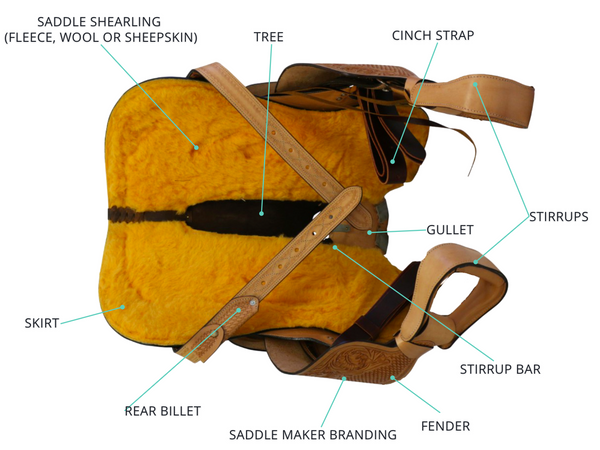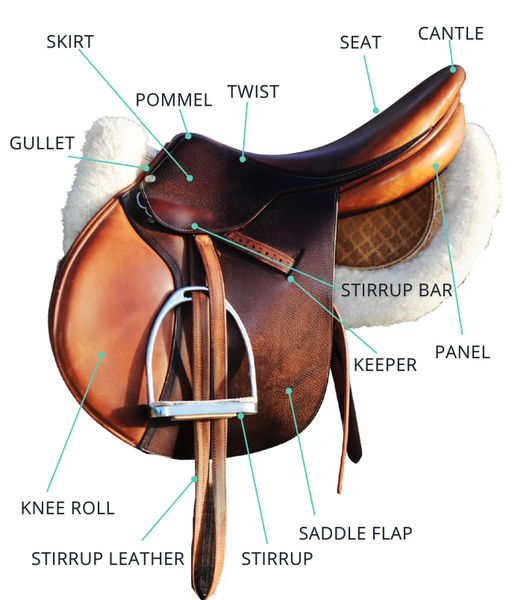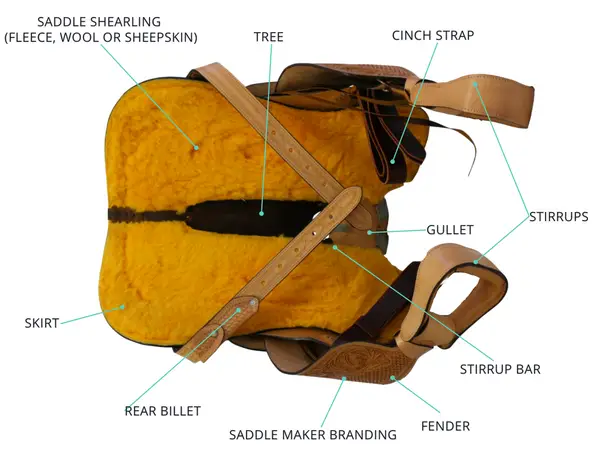Introduction

In the world of horseback riding the horse’s saddle is among the most important items of equipment. If you’re a novice or a veteran rider knowing the parts of a saddle will greatly enhance you riding. A well-designed saddle can provide stability, comfort and control for the horse and the rider. In this article we will look at the primary parts of a saddle and their roles and the ways they can aid in a successful riding experience.
Major Parts of a Saddle

1. Pommel
The pommel is the upper portion of the saddle’s front. It offers support to the hands of the rider, and also helps to maintain a stable posture. In English saddles the pommel is small. In Western saddles, it’s more prominent.
2. Cantle
It is situated in the rear of the seat The cantle is located at the back of the seat. It is a security and support for the passenger. A cantle that is high provides greater back support, whereas the lower model allows for more mobility.
3. Seat
Its Seat is where the rider is. It must be well-designed and comfortable to suit the body of the rider. English saddles are designed with a more rounded seat, but Western saddles usually have a more rounded seat for greater stability.
4. Saddle Tree
The tree is the base for the saddle. It determines its shape the fit, shape, and the distribution of weight. Traditional saddles are made of wood Modern versions make use of synthetic materials.
5. Gullet
The Gull is the space like a tunnel beneath the pommel. It makes sure there’s enough room in order for the horses spine to avoid the pressure and discomfort.
Additional Saddle Components
6. Flaps (English Saddles) & Skirts (Western Saddles)
- Flaps (English Saddles) The flaps are designed to protect the rider’s leg while holding the leathers on the stirrups in the correct position.
- Skirts (Western Saddles) The rigging is covered and distributes pressure more equally.
7. Stirrups & Stirrup Leathers
- Stirrups Offer support for your foot increasing stability and control.
- Stirrup Leathers Straps with adjustable straps that connect the stirrups and the saddle.
8. Fenders (Western Saddles Only)
The Fenders are large leather panels which hang off the back of the horse, linking the stirrups with the tree, and protecting riders’ legs.
9. Girth (English Saddles) & Cinch (Western Saddles)
- Girth An elastic strap which connects the English saddle to a horse.
- Cinch Cinch is the Western version of the saddle typically made of fleece, leather or synthetic materials.
10. Horn (Western Saddles Only)
The Horn is an important feature of Western saddles, which are used to rope and provide additional support.
Other Important Features of a Saddle
11. Panels (English Saddles) & Bars (Western Saddles)
- Panels (English Saddles) The padding beneath the saddles, which helps distribute the weight equally.
- Bars (Western Saddles): A structural element in the tree of saddles which determines the position of the saddles upon the horses.
12. D-Rings
They are a set of metal rings that attach to the saddle. They allow riders to secure their accessories such as saddle bags, breastplates or other training aids.
13. Billets & Latigo Straps
- Billets (English Saddles): Straps of leather used to secure the girth.
- Latigo Straps (Western Saddles) Straps that are long and used to fix the cinch securely to the horses.
14. Knee Rolls & Thigh Blocks (English Saddles Only)
The padded areas of English saddles give extra support and stability to the riding leg of the rider.
15. Conchos & Decorative Elements (Western Saddles Only)
Western saddles typically feature intricate tools, silver conchos and a decorative stitching to add design.
Choosing the Right Saddle
The choice of a saddle is based on factors like your riding style, the anatomy of your horse and individual ease. A properly fitted saddle can improve performance and helps prevent injuries or discomfort. The rider should take into consideration:
- What kind of riding they engage in (e.g. dressage or jumping trails, riding on trails, or working on ranches).
- The shape of the horse’s body and back structure.
- Its padding, material and overall shape.
- Their comfort level and posture during riding.
Proper Saddle Maintenance
- Cleansing Regularly: Clean the leather after every ride, and apply the leather cleaner and conditioner.
- Examine for wear and tears Check the leathers on the girth, stirrups and billets for indications of wear or tear.
- Storage Properly: Store your saddle cool, dry location, and preferably with a saddle rack in order to preserve its form.
- oiling & Conditioning Apply saddle oil regularly in order to maintain the softness of your leather and keep it smooth.
Conclusion
Knowing the parts of a saddle lets riders make educated choices and keep their equipment in good condition. If you’re riding English or Western an appropriately fitted saddle can improve ease of riding and control. With these fundamental elements, you can guarantee the most enjoyable riding experience for both you and your horse.

